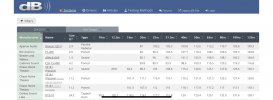audioresearch
Member
- Joined
- Jul 15, 2023
- Messages
- 12
- Likes
- 8
I'm interested in people's opinions about how low the lowest frequency a subwoofer/woofer can produce with "acceptably low" distortion should be.
I'm interested only in the lowest frequency that can be heard, not just felt, regardless of how high the spl level needs to be for that to happen. I once heard a subwoofer being demonstrated which rattled the metal door on a wall-mounted electric service box on the other side of the room but I heard nothing whatever other than that metal door shaking-I do not care about the room vibrating or things in the room vibrating and making their own sounds, I only care about what I can hear that is emanating from the speaker.
Also, I am interested in people's opinions as to whether the spl level of the lowest frequency that can be heard needs to be so high to sound "loud" that it will cause hearing damage. What spl level at 20Hz is the threshold for causing hearing damage if listened to continuously?
I did not define above "acceptably low distortion" or "loud"-please give your own opinions on what values those should be.
I hope Amir can reply to this as I'm very curious to know his opinions. And by the way, Amir, thank you very much for the work you are doing and for the fact you base your work on science & audio engineering such as research findings from the AES and some of its well known luminaries such as Floyd Toole and Klippel.
I'm interested only in the lowest frequency that can be heard, not just felt, regardless of how high the spl level needs to be for that to happen. I once heard a subwoofer being demonstrated which rattled the metal door on a wall-mounted electric service box on the other side of the room but I heard nothing whatever other than that metal door shaking-I do not care about the room vibrating or things in the room vibrating and making their own sounds, I only care about what I can hear that is emanating from the speaker.
Also, I am interested in people's opinions as to whether the spl level of the lowest frequency that can be heard needs to be so high to sound "loud" that it will cause hearing damage. What spl level at 20Hz is the threshold for causing hearing damage if listened to continuously?
I did not define above "acceptably low distortion" or "loud"-please give your own opinions on what values those should be.
I hope Amir can reply to this as I'm very curious to know his opinions. And by the way, Amir, thank you very much for the work you are doing and for the fact you base your work on science & audio engineering such as research findings from the AES and some of its well known luminaries such as Floyd Toole and Klippel.



